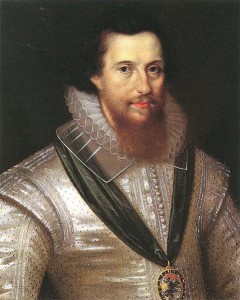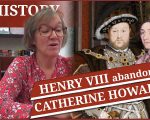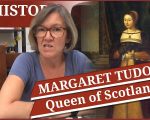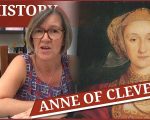Brilliant presentation! I was in Scotland last month. My second trip to Edinburgh, but my first visit to Holyrood House, and it’s wonderful! Now I must go back in order to visit some of the other Mary, Queen of Scots places you showed us.
YOUR SEARCH UNCOVERED 2137 RESULTS
-
Margaret
-
25 November – The coronation of Elizabeth of York

On this day in Tudor history, 25th November 1487, the Feast of St Catherine, Elizabeth of York, queen consort of Henry VII and mother of one-year-old Arthur Tudor, was crowned queen at Westminster Abbey.
In today’s talk, I share details of Elizabeth of York’s coronation, including Elizabeth’s apparel, and who attended, plus a list of some of the interesting dishes served at Elizabeth of York’s coronation banquet which included swan and seal!
[Read More...] -
20 November – Sir Christopher Hatton Elizabeth I’s mouton and lids

On this day in Tudor history, 20th November 1591, Sir Christopher Hatton, Elizabeth I’s Lord Chancellor and favourite, died aged fifty-one. He was such a favourite of Queen Elizabeth I that he had a dazzling career and was constantly at her side.
Find out more about Sir Christopher Hatton, his career and accomplishments, his patronage of learned men and explorers, and his special relationship with Elizabeth I, in today’s talk.
[Read More...] -
19 November – An important member of the Catholic underground dies

On this day in Tudor history, 19th November 1587, Henry Vaux died of what was probably consumption at Great Ashby, the home of his sister, Eleanor Brooksby.
Henry Vaux is a fascinating Tudor man. He started out as a precocious child and poet, and grew up to be an important member of the Catholic underground. He was a Catholic recusant and priest harbourer, helping Jesuit priests in the Protestant reign of Queen Elizabeth I, both financially and by giving them a roof over the heads.
In today’s talk, I introduce Henry Vaux and what happened to him in Queen Elizabeth I’s reign.
Book Recommendation: One of my very favourite history books is “God’s Traitors: Terror and Faith in Elizabethan England” by Jessie Childs.
[Read More...] -
16 November – A strange Elizabethan Plot

On this day in history, 16th November 1612, Elizabethan conspirator, William Stafford, died. He’s an interesting Tudor character because he had Plantagenet blood and also because he was allegedly the chief plotter in the Stafford Plot, a plot to assassinate Queen Elizabeth I, but he was only imprisoned for a short time and lived the rest of his life quietly in Norfolk, dying a natural death.
How and why did William Stafford escape serious punishment for the Stafford Plot and what did Sir Francis Walsingham have to do with it all?
Find out about William Stafford and the Stafford Plot in today’s talk.
[Read More...] -
Robert Devereux, 2nd Earl of Essex (1565-1601)


Robert Devereux, 2nd Earl of Essex, after Marcus Gheeraerts the Younger
Robert Devereux, 2nd Earl of Essex, was born on this day in history, 10th November 1565, at Netherwood, Herefordshire. To commemorate the birth of this man, one of Elizabeth I's favourites, I thought I'd share this mini biography of him, along with a few videos I did.
Devereux was the eldest son of Walter Devereux, 1st Earl of Essex, and Lettice Knollys, granddaughter of Mary Boleyn, and was a favourite of Elizabeth I. After his father's death in 1576, William Cecil, Lord Burghley, was made his guardian, and in 1578 his mother married his godfather, Robert Dudley, Earl of Leicester.
Essex first caught the Queen's attention in 1584 when his stepfather, Leicester, brought him to court, and he was appointed Master of the Horse on his return to court after successful military service in the Netherlands with his stepfather. He was just twenty-one, and the Queen was fifty-three.
Although Robert Devereux is often described as "the darling of Elizabeth's old age", having replaced his stepfather in Elizabeth's affections after Dudley's death in 1588, Alison Plowden says that "it would probably be more accurate to describe him as one of its greatest headaches". Although Essex was dashing and charming, he was rash, ambitious, arrogant, headstrong and used to getting his own way. Unlike Dudley, Essex did not know Elizabeth as only a childhood friend or sweetheart can, and he constantly underestimated her and attempted to bully her into submission.
After a successful raid on Cadiz in 1596 during the war with Spain, Essex returned to England as a hero. His return to court caused the forming of two factions: the Devereux faction, who were seeking military profit and glory, and the opposing faction headed by Lord Burghley and his son, Robert Cecil, who were on the side of peace. Although Elizabeth loved flirting with the handsome Essex and doted on him, she sought to keep a balance between the factions, and would not always give her favourite what he wanted. This led to Essex sulking like a spoiled child, and to stormy rows between him and the Queen. Essex ignored the advice of friends like Francis Bacon, who warned him not to offend Elizabeth by seeking to be overly powerful, because he did not want to settle for 'just' being a servant like his stepfather. He wanted more. Wise counsel fell on deaf ears, and Elizabeth's attempts to tame wild-child Essex failed.
Ultimately, it was his pride and his need for recognition and power that led to his undoing. In 1599, Essex became Lord Lieutenant of Ireland, but his campaign against the Irish was unsuccessful. Essex constantly ignored the Queen's orders, acted contrary to her wishes and constantly worried about what the Cecil faction were getting up to back at court. His obsession with power led to him giving up on the Irish situation, making a truce with the Irish rebel leader (against the Queen's wishes) and returning to England without the Queen's permission. This amounted to desertion and disobedience, something which Elizabeth could not and would not tolerate. The situation was made worse on the 28th September 1599, by Essex striding into Elizabeth's bedchamber unannounced and seeing the Queen without her makeup or wig, without her "mask of youth". You can read more about this event in my article here.
On the 29th September, Essex was interrogated before the Queen's Council for around 5 hours, and the Council concluded that his truce with the Irish rebels was indefensible, and that his return to England was a desertion of duty. Essex was then put under house arrest. In June 1600, Essex appeared before a special court and was punished by being deprived of his public office and being confined to his home. However, in August, he was granted his freedom, although his sweet wines monopoly, his one source of income, was not renewed.
He may well have wormed his way back into the Queen's affections if he had apologised and appealed to the Queen for mercy - after all, she had a soft spot for him and was used to his impulsive behaviour - but Essex made the fatal mistake of trying to enlist the support of the Scottish king, James VI, against Cecil's faction at court, and planning a coup for March 1601 to force Elizabeth to summon Parliament and deal with Cecil and his faction. When, on the 7th February, Essex received a message from the Queen that he was to present himself before Council, he decided to move things forward and summoned three hundred followers, telling them that Cecil and Ralegh were planning to assassinate him, and that the rising should therefore take place the next day, instead of in March.On the 8th February 1601, Essex, his supporters and two hundred soldiers gathered at Essex House. Essex then marched into the city crying "For the Queen! For the Queen! The crown of England is sold to the Spaniard! A plot is laid for my life!" but London's citizens remained indoors instead of joining him on his march. As his supporters deserted him, Essex was forced to give up and return home, where he surrendered after Lord Admiral Nottingham threatened to blow up his house if he did not give himself up.
Robert Devereux by Isaac Oliver
On the 9th February, Elizabeth I told the French ambassador that the "shameless ingrate, had at last revealed what had long been in his mind". Her patience had been stretched beyond breaking point and she could no longer excuse her past favourite's behaviour. On the 13th February the full details of the coup planned by Essex were made public, and on the 17th February indictments were laid against Essex and his key supporters, including Henry Wriothesley, 4th Earl of Southampton. Two days later, on the 19th February, Robert Devereux, Earl of Essex, and his friend, Southampton, were tried at Westminster Hall by a jury of their peers. Both men were accused of high treason, found guilty and sentenced to death. Elizabeth I, in her mercy, commuted Southampton's sentence to life in prison and Essex's sentence of a traitor's death to death by beheading. On the 20th February, the Queen signed his death warrant.
Essex was executed on Tower Green on the 25th February 1601.
Taken from On this Day in Tudor History by Claire Ridgway.
-
10 November – Cats, pigeons and lions

On this day in Tudor history, 10th November 1536 (some sources say 1537), Sir Henry Wyatt of Allington Castle, politician, courtier, Privy Councillor and father of poet Sir Thomas Wyatt the Elder, died.
Sir Heny Wyatt was an important man, but rather than tell you about his career, Claire Ridgway, author of “On This Day in Tudor History”, thought she’d share with you two interesting stories concerning this Tudor man and cats, pigeons and a lion.
[Read More...] -
8 November – King Henry VIII praises one wife while trying to marry another!

On this day in Tudor history, 8th November 1528, at Bridewell Palace, King Henry VIII made a rather strange public oration to “the nobility, judges and councillors and divers other persons” to explain his troubled conscience regarding the lawfulness of his marriage to his first wife, Catherine of Aragon.
In today’s talk, I share an extract from the king’s speech, in which he praises Catherine of Aragon to the hilt even though he’d proposed to another woman, Anne Boleyn. Find out all about this strange situation!
[Read More...] -
6 November – Henry VIII abandons Catherine Howard

On this day in Tudor history, Sunday 6th November 1541, Catherine Howard, Henry VIII’s fifth wife, was abandoned by her husband the king at Hampton Court Palace. She would never see him again.
On the same day, Queen Catherine was visited by a delegation of king’s council members and informed of allegations made against her.
What exactly happened on this day in 1541 and what has this to do with Hampton Court Palace’s ‘Haunted Gallery’? Find out in today’s talk.
[Read More...] -
November’s live chats – 9 and 29 November 2019

We have two live chats in the Tudor Society chatroom this month, as usual. The first is our informal live chat on Tudor scandals, which will take place on Saturday 9th November, and the second is our expert live chat with Gayle Hulme on Mary, Queen of Scots, which will take place on Friday 29th November.
[Read More...] -
Live chat transcript – Lauren Johnson – Henry VI

Thank you so much to everyone who attended our October expert live chat with historian Lauren Johnson, and a big thank you to Lauren for being so giving of her time. It was a wonderful hour.
If you missed it, you can catch up with this transcript:
[Read More...] -
November 2019 – Tudor Life – Tudor Scandals

Here's the full 72 page version of your monthly magazine: November's Tudor Life magazine, packed with articles about Tudor Scandals...
This month the magazine contains:
- The death of Amy Robsart by Sarah-Beth Watkins
- Thomas Seymour and the Young Elizabeth I by Claire Ridgway
- Gayle Hulme Expert Speaker on The Places of Mary, Queen of Scots
- The Boleyns: A Family Scandal by Roland Hui
- Popular Tudor Figures a quiz by Catherine Brooks
- The Scandals of the Tudors: Reign by Reign by Gareth Russell
- Sir John Gates, Tudor Courtier by Susan Abernethy
- Special events at The Mary Rose
- The Burial of Queen Jane Seymour by Elizabeth Jane Timms
- Sons of Scandal by Gareth Russell
- Tudor Life Editor’s Picks: books on Tudor Scandal
- Tudor Society Members’ Bulletin by Tim Ridgway
- Pastimes in Good Company: Part II by Tony Mount
- Devices and Desires/Boleyn Gold book reviews by Charlie Fenton
- Thinking about writing by Wendy J. Dunn
- Helping others to enjoy history an interview with Beth von Staats
- Cibos Venerem Incitantes: Tudor aphrodisiacs by Rioghnach O’Geraghty
- November’s On this day by Claire Ridgway
-
29 October – “Strike, man, strike” – The end of Sir Walter Ralegh

On this day in history, 29th October 1618, in the reign of King James I, Elizabethan courtier, explorer, author and soldier, Sir Walter Ralegh (Raleigh, Rawley, Ralagh, Rawleigh) was executed in the Old Palace Yard at Westminster Palace.
Ralegh had led an eventful life. He’d been a favourite of Elizabeth I – except when he secretly married her lady, Bess Throckmorton – but had been imprisoned in the Tower of London on several occasions, he’d been accused of atheism at one point, had sailed to America and tried to establish a colony, he was knighted for his service in Ireland, and he was a poet too!
Find out all about Sir Walter Ralegh’s colourful life in today’s talk.
[Read More...] -
27 October – Anne Boleyn makes an entrance

On this day in Tudor history, Sunday 27th October 1532, Anne Boleyn, Marquess of Pembroke, made a dramatic entrance to the great banquet held by King Henry VIII in Calais in honour of King Francis I of France.
I share details from contemporary sources regarding the banquet and the masque that followed. Anne Boleyn definitely knew how to make and entrance and the English ladies must have looked spectacular. You’ll recognise some of the names of Anne’s ladies and those present in Calais.
[Read More...] -
22 October – A Catholic baron who fled abroad

On this day in Tudor history, 22nd October 1577, Henry Parker, 11th Baron Morley and Roman Catholic exile, died in Paris. Morley had fled abroad in 1570 after refusing to subscribe to Elizabeth I’s “Act of Uniformity” and after being implicated in the 1569 Rising of the North.
Find out more about this Tudor man, who was the nephew of Jane Boleyn, Lady Rochford, and his rather interesting family, with their connections to the trial of Mary, Queen of Scots and the Gunpowder Plot, in today’s video.
[Read More...] -
18 October – Margaret Tudor, Queen of Scotland

On this day in Tudor history, 18th October 1541, Margaret Tudor, sister of King Henry VIII and eldest daughter of King Henry VII, died of a stroke at Methven Castle, Perthshire, Scotland. She was laid to rest at the Carthusian Priory of St John in Perth, which was later destroyed.
Margaret Tudor is a fascinating Tudor lady. She was sent to Scotland at 13 to marry King James IV, she was widowed, divorced and unhappily married, she fled to England at one point, and she was the mother of Lady Margaret Douglas, grandmother of Mary, Queen of Scots AND Lord Darnley, and great-grandmother of King James VI of Scotland (King James I of England). What a life she had!
Find out all about Margaret Tudor in today’s talk.
[Read More...] -
11 October – A procession and prayers for Queen Jane Seymour

On this day in Tudor history, 11th October 1537, poor Jane Seymour was in labour with her first and only child, Edward VI.
It was a long and difficult labour, and on 11th October, there was a solemn procession in the city of London to pray for her. After about thirty hours, Jane gave birth to a healthy baby boy, who would become King Edward VI.
In today’s talk, I share contemporary sources about the procession and Jane’s labour.
[Read More...] -
10 October – Elizabeth I comes down with Smallpox

On this day in Tudor history, 10th October 1562, twenty-nine-year-old Queen Elizabeth I was taken ill at Hampton Court Palace, with what was thought to be a bad cold. However, Elizabeth actually had smallpox.
It was thought that the queen would die, so there was panic over the succession, and it was at this point that Elizabeth chose Robert Dudley as “protector of the kingdom”. However, Elizabeth I survived and went on to reign until her death in March 1603.
Elizabeth was nursed by her good friend, Mary Sidney, who also came down with smallpox and was badly disfigured by it.
[Read More...] -
Charles Brandon’s Marriage to Katherine Willoughby – Guest article by Tony Riches

Charles Brandon, Tudor knight and best friend of King Henry VIII, is best known for secretly marrying Mary Tudor, the king’s sister – without Henry’s permission! Less well known is his last marriage, to Lady Katherine Willoughby.
[Read More...] -
2 October – William Tyndale, Anne Boleyn and a book for “all Kings to read”

On this day in Tudor history, 2nd October 1528, reformer and Bible translator William Tyndale’s book “The Obedience of a Christian Man” was published in Antwerp.
A copy of this book owned by Anne Boleyn ended up being a catalyst of the English Reformation when it was confiscated from the suitor of one of Anne’s ladies as a heretical book. Henry VIII ended up reading it and proclaiming that “This Book is for me and all Kings to read.” It set him on his path to the break with Rome and saw him marrying Anne Boleyn as his second wife.
Find out the full story in this talk…
[Read More...] -
Edward VI – The good, the bad and the ugly

In this week’s Claire Chats talk, I am continuing my series on the Tudor monarchs, and examining their reigns for “the good, the bad, the ugly”, i.e. their achievements and the not-so-good stuff, by looking at the reign of the third Tudor monarch, King Edward VI.
Of course, Edward VI died before he reached his majority, so in examining his reign I have to look at “the good, the bad and the ugly” of the two men who led his government: Edward Seymour, Duke of Somerset, and John Dudley, Duke of Northumberland.
[Read More...] -
26 September – Sir Francis Drake, the Golden Hind and a whole lot of treasure

On this day in Tudor history, 26th September 1580, in the reign of Queen Elizabeth I, Sir Francis Drake returned from his 3-year circumnavigation of the Globe. Drake landed at the port of Plymouth, in his ship, The Golden Hind, which was laden with treasure and spices.
In today’s talk, I give details about his circumnavigation of the Globe, what he brought back, and how Queen Elizabeth I rewarded him for his efforts.
[Read More...] -
25 September – A pope, death cap mushrooms and poisoned candles

On this day in Tudor history, 25th September 1534, Pope Clement VII (Giulio di Giuliano de’ Medici) died in Rome. It was rumoured that he died from eating death cap mushrooms or from fumes from poisoned candles placed in his room, but it was more likely to have been from natural causes.
In today’s video, I introduce this pope, who was the leader of the Catholic Church at rather an interesting time, and also look at the rumours surrounding his death and what eating a death cap mushroom does. Lovely stuff!
[Read More...] -
22 September – Anne of Cleves, fourth wife of Henry VIII

This day in Tudor history, 22nd September 1515, is the traditional birthdate of Anne of Cleves, or Anna von Jülich-Kleve-Berg, a woman who would become King Henry VIII’s fourth wife and queen consort, but only for six months!
She may have only been queen for six months, but Anne of Cleves outlived Henry and all of his wives, and seems to have had a very good life.
Find out more about her and how she came to be Henry VIII’s queen in today’s talk.
[Read More...] -
20 September – Arthur Tudor, Prince of Wales

On this day in Tudor history, 20th September 1486, King Henry VII’s wife, Elizabeth of York, gave birth to the couple’s first child at Winchester.
The baby was a boy and was baptised Arthur, named after the legendary King Arthur. There were high hopes for this boy and King Henry VII believed that his firstborn would be a powerful king who would bring a golden age to the country. Of course, things wouldn’t go according to plan.
Find out more about Arthur Tudor, Prince of Wales, who was, of course, Catherine of Aragon’s first husband, in today’s talk from Claire Ridgway, founder of the Tudor Society.
[Read More...] -
15 September – A Tudor Taxman – John Morton

On this day in Tudor history, 15th September 1500, in the reign of King Henry VII, John Morton, Archbishop of Canterbury, cardinal and Henry’s Lord Chancellor, died at Knole in Kent.
John Morton was not a very popular man with the English people due to his role in Henry VII’s financial policies, although at least he died of plague rather than being executed like his colleagues, Empson and Dudley.
One tax rationale he’s associated with is Morton’s Fork, but was it really down to him?
Find out the answer and find out more about this Tudor taxman in today’s talk.
[Read More...] -
14 September – Henry VIII, the shrine destroyer

Yes, on this day in Tudor history, 14th September 1538, a religious shrine which had stood since the early 12th century, was destroyed on the orders of King Henry VIII. The Shrine of Our Lady of Caversham was destroyed as part of Henry VIII’s Dissolution of the Monasteries.
In today’s talk, I share contemporary accounts of the shrine’s destruction, which included details of what was seized and sent to London.
[Read More...] -
10 September – Elizabeth I’s christening

On this day in Tudor history, 10 September 1533, King Henry VIII and Queen Anne Boleyn’s daughter, Elizabeth (the future Queen Elizabeth I), was christened at the Church of Observant Friars in Greenwich.
Elizabeth I’s christening service was a lavish ceremony presided over by Archbishop Thomas Cranmer, who also stood as the little girl’s godfather.
In today’s talk, I share a contemporary source of Elizabeth’s christening service and also of the celebrations that followed.
[Read More...] -
9 September – Catherine of Aragon and the mystery of James IV’s body

On this day in Tudor history, 9th September 1513, during the reign of King Henry VIII, English and Scottish forces clashed at the bloody Battle of Flodden.
Henry VIII was campaigning in France at the time, so Catherine of Aragon was in charge as regent. It was a victory for Catherine and also for Thomas Howard, Earl of Surrey, who led the English troops against the Scots on that day. Henry missed this moment of victory.
King James IV of Scotland died at the Battle of Flodden, but what happened to his body?
In today’s talk, I give details of the battle, Catherine’s role in England’s victory, and explains what is thought to have happened to James IV’s remains.
[Read More...] -
8 September – The mysterious death of Amy Robsart, wife of Robert Dudley

On this day in Tudor history, 8th September 1560, the body of Amy Dudley (née Robsart), wife of Robert Dudley, Earl of Leicester, was found at the bottom of some stairs in her rented home, Cumnor Place in Oxfordshire.
What had happened to Amy? Was her death a result of “misfortune”, as decided by the coroner, or was it suicide or murder? Did Robert Dudley kill his wife? Did William Cecil kill Amy?
In today’s talk, Claire Ridgway, founder of the Tudor Society, examines what happened that day and the theories regarding Amy Robsart’s mysterious death, an event that definitely put an end to the idea that Elizabeth I could ever marry Robert Dudley.
[Read More...]


